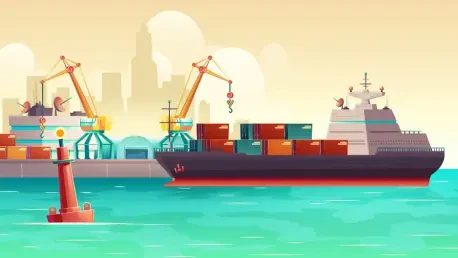Charting a New Course in Maritime Sustainability
In the heart of the North Sea, Norway’s offshore fleet is steering a seismic shift in the maritime industry, with battery-hybrid technology slashing fuel consumption by up to 75% in some vessels, underscoring a broader market movement toward sustainability. This positions Norway as a frontrunner in green maritime operations. This market analysis delves into the trends, data, and projections surrounding battery electrification in offshore workboats—spanning supply vessels, service operation vessels (SOVs), and construction vessels. The purpose is to unpack how these innovations are reshaping operational efficiency and environmental impact, particularly within the rapidly expanding offshore wind energy sector, while offering strategic insights for stakeholders navigating this evolving landscape.
Unpacking Market Trends in Battery Adoption
Fuel Efficiency as a Competitive Edge
A defining trend in Norway’s offshore market is the remarkable fuel efficiency gained through battery-hybrid systems. Data from recent vessel deployments highlights that modern SOVs consume significantly less fuel compared to older models. For instance, a leading battery-hybrid SOV now uses under three tons of fuel per day during standby operations at offshore facilities, a sharp decline from the 12 tons typical of vessels from earlier designs. This efficiency translates into substantial cost savings over time, despite higher initial investment costs, making hybrid systems an attractive proposition for operators aiming to reduce operational expenses in a competitive market.
Operational Reliability in Demanding Environments
Beyond cost savings, battery technology is redefining operational standards for offshore fleets facing harsh North Sea conditions. Systems equipped with peak shaving capabilities manage sudden propulsion load changes, allowing engines to maintain optimal efficiency levels. This ensures reserve power for critical functions like dynamic positioning, often requiring just a single generator running at an ideal 80-85% load range. Such advancements minimize downtime and enhance precision during complex tasks like mooring or crane operations, giving Norwegian operators a distinct advantage in reliability and safety over traditional setups, and driving market preference for hybrid vessels.
Sustainability as a Market Driver
Sustainability is another pivotal force shaping market dynamics, with Norway’s offshore sector aligning closely with global environmental targets. Battery electrification supports international efforts to reduce maritime emissions, particularly as the industry braces for stricter regulatory frameworks. The push toward net-zero goals is encouraging hesitant shipowners to explore efficiency upgrades, especially as demand grows for vessels supporting offshore wind projects. While challenges like limited shore charging infrastructure persist in some regions, Norway’s proactive adoption of green technologies is creating a ripple effect, positioning the country as a benchmark for sustainable maritime solutions worldwide.
Data-Driven Insights and Market Projections
Current Adoption Rates and Investment Patterns
Analyzing current market data reveals a steady uptick in the adoption of battery-hybrid systems within Norway’s offshore fleet. Industry reports indicate that over 30% of newbuild SOVs and construction vessels commissioned since 2025 incorporate hybrid technology, a figure expected to rise as retrofit programs gain traction. Investment in battery systems is also seeing growth, fueled by government incentives and partnerships with technology providers. However, upfront costs remain a barrier for smaller operators, highlighting a market disparity between large firms with capital reserves and niche players struggling to fund transitions.
Projected Growth in Offshore Wind Support
Looking ahead, projections suggest that battery-powered vessels will play a central role in supporting the offshore wind energy boom through 2027 and beyond. Market forecasts estimate a 40% increase in demand for hybrid SOVs tailored for wind farm maintenance, driven by Europe’s ambitious renewable energy targets. Complementary technologies, such as walk-to-work systems for safe personnel transfers, are also expected to see heightened integration, further boosting vessel efficiency. These trends point to a robust growth trajectory for Norway’s offshore market, with battery innovation as a key differentiator in securing contracts within the renewable sector.
Emerging Technologies and Regulatory Impacts
Emerging digital tools for ship management are set to complement battery systems, offering real-time data analytics to optimize fuel use and operational planning. On the regulatory front, anticipated stricter emissions standards could accelerate global adoption of hybrid vessels, though economic uncertainties and infrastructure gaps may temper the pace of change in some markets. Norway’s ability to navigate these challenges through early investment in shore power facilities and policy support provides a model for other regions. The market outlook remains optimistic, with fully electric vessels potentially viable for shorter offshore routes within the next decade, further reducing fossil fuel dependency.
Reflecting on Market Implications and Strategic Pathways
Looking back, this analysis illuminated how Norway’s offshore fleet leveraged battery innovation to redefine market standards, achieving unprecedented fuel efficiency and operational reliability while aligning with sustainability imperatives. The data underscored a clear trend of growing adoption, with projections signaling robust demand driven by the offshore wind sector. For stakeholders, the path forward involves strategic investments in hybrid retrofits and newbuilds, capitalizing on incentives to offset initial costs. Collaboration with technology providers proves essential, as does advocacy for expanded shore charging infrastructure to bridge market gaps. These steps not only address immediate operational needs but also position firms to lead in a decarbonized maritime future, ensuring long-term competitiveness in an industry under transformation.









